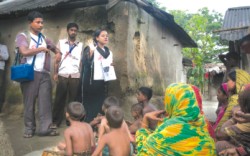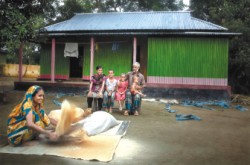|
Health
A New Approach to
Disease Control
Erin Halligan
 |
MSF Outreach workers in Fulbaria, Mymensingh explain to villagers that the new treatment only takes 5 days, unlike the old procedure which required 30 days of painful injections. Behind them is a mud-plastered house where infected sandflies thrive. Photo credit: 2010 Gazi Nafis Ahmed/MSF |
The recently opened Médecins Sans Frontières (MSF) programme in Fulbaria, Mymensingh aims to treat over 3,000 sufferers of kala azar, the world's second deadliest parasitic killer after malaria, in the next two years. The innovative approach is paving the way forward for disease control in Bangladesh.
Health and disease prevention programmes have constantly faced the challenge of accessing 'at risk' populations before epidemics strike. Competing issues of poverty, discrimination and lack of education have often meant that health interventions were reactionary to diseases, making it difficult to provide comprehensive access to treatments. However, in a progressive step to overcome these challenges, a new clinic in Fulbaria, Mymensingh, is taking a hands-on approach to providing proactive health treatment and education for thousands of kala azar sufferers in the area.
According to the World Health Organisation, of the estimated 500,000 people in the world infected each year, 100,000 are thought to live in Bangladesh, Nepal and India. The disease is now being reported in 45 districts in Bangladesh with the upazilas of Trishal and Fulbaria, in the district of Mymensingh, reporting 60% of all cases in the country (according to the Ministry of Health).
Kala azar, more formally known as visceral leishmaniasis, is caused by a parasite transmitted to humans by infected female sandflies. It affects the immune system, giving rise to secondary infections such as pneumonia, diarrhoea, and tuberculosis, causing persistent fever, anaemia and weight loss and is responsible for over 50,000 deaths a year worldwide.
A local, Md. Mohammed Jalal Uddin, knows all too well the devastation the disease can cause. The 55-year-old sits and waits patiently in the MSF Kala Azar Centre as his 15-year-old granddaughter receives treatment.
“I lost my wife and two daughters to kala azar 10 years ago. I didn't know what the illness was and no one else could tell me either. One after another they all passed away. Now I don't want to lose my grand-daughter Afia,” said Jalal Uddin.
For a disease that has been around for centuries, it is surprising how little we know about it.
Shefali Aktar, 30, also receiving treatment, suffered severe fever for two months before visiting the centre. Sitting with her mother and father she talks of how she had received some medication from a village doctor, but was left with the understanding that she may have contracted typhoid.
The lack of economic gain to be made from a disease that mostly affects the poor has meant that drug companies and G20 governments have been unwilling to invest huge sums of money into research and development. As a result of the lack of interest, we also have a corresponding lack of understanding. Kala azar experts are still unsure why it strikes some members of the family and not others, or why post kala azar dermal leishmaniasis, the extraordinary skin condition known as PKDL, only occurs in some patients after a treatment. Even though there is treatment for the disease, there is still currently no vaccine available for kala azar.
 |
When Mohammed Abdur Rahman, 45, a local farmer, found out that kala azar is prevalent in mud-plastered houses, he immediately took down his house and rebuilt it with tin. Photo credit: 2010 Gazi Nafis Ahmed/MSF |
In the past, governments have tended to manage the spread of parasitic diseases such as kala azar and malaria primarily through vector control. Although vector control has proven to be successful in reducing disease, particularly in the case of malaria, it requires huge amounts of money and infrastructure to implement, and large amounts of harmful insecticides to be sprayed regularly.
The Ministry of Health is planning to conduct vector control activities, but will implement it as part of a two-pronged attack in partnership with MSF.
Dr Anjuman Ara, an MSF doctor working at the centre, explains MSF's approach, “MSF is adopting an integrated programme comprising of 'active case finding' within the community to identify patients with the disease, followed by treatment with AmBisome, an effective drug included in the national kala azar protocol, but yet to be used in Bangladesh.”
Active case finding has been used in some health interventions internationally, particularly in the management of tuberculosis, but this is the first time such a method has been used in this setting in Bangladesh.
This approach will bridge the huge gap in accessing kala azar patients in Mymensingh as outreach workers will seek out people in vulnerable areas who are in need of help or advice, rather than waiting for those people to access the clinic. The workers travel door-to-door talking with villagers, conducting symptomatic testing, making referrals to treatment, following up on treatment and most importantly, providing educational support on the disease.
Health interventions like this are an essential step in overcoming the barriers of access to treatment for those who are at risk of being infected, and help create long term, sustainable health promotion outcomes that empower people to understand their right to health.
Presently there is no vaccine for kala azar, so efficient treatment is imperative to managing the symptoms.
The previous treatment, SSG (Sodium Stibo Gluconate), required 30 days of painful intramuscular injections. This not only deterred patients from following up on their treatment, but it also had an impact on their livelihoods. This length of time often meant patients would have to forfeit work, domestic responsibilities, or school.
When Mohammed Abdur Rahman, 45, a local farmer, found out that kala azar is prevalent in mud-plastered houses, he immediately took down his house and rebuilt it with tin.
“I can't afford to take time off work. Who will support my family?” said Rahman.
“With AmBisome, we can now treat a patient in five days with three infusions. This hugely reduces the amount of time a patient has to spend in hospital” said Dr Anjuman Ara.
Over 200 million people remain at risk from kala azar throughout the South Asia region, an alarming statistic that prompted health ministers from Nepal, India and Bangladesh (where the disease is endemic) to sign a Memorandum of Understanding in May 2005, pledging to collaborate to eliminate kala azar from the region by 2015 in line with the Millennium Development Goals. If the three countries are to reach their target, more innovative approaches to health, such as this one in Fulbaria, are needed.
Proactive, face to face health programmes such as the MSF 'active case finding' method in the Kala Azar Treatment Centre is a positive move in the right direction.
Health interventions like the MSF programme are an essential step in overcoming the barriers of access to treatment for those who are at risk of being infected, and can help create long term, sustainable outcomes that empower people to understand their right to healthcare.
Erin Halligan is a health advocacy consultant working in Bangladesh.
Copyright
(R) thedailystar.net 2010
|

